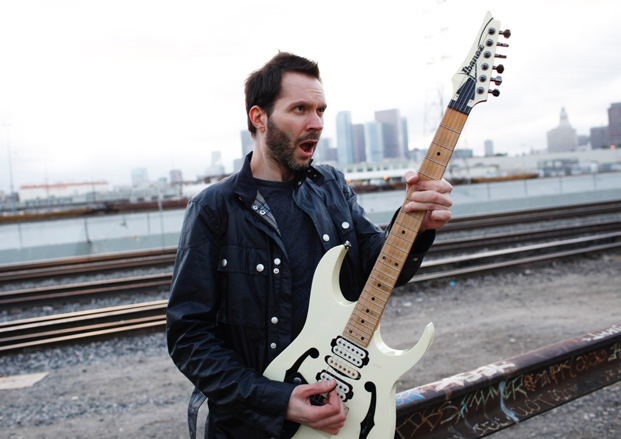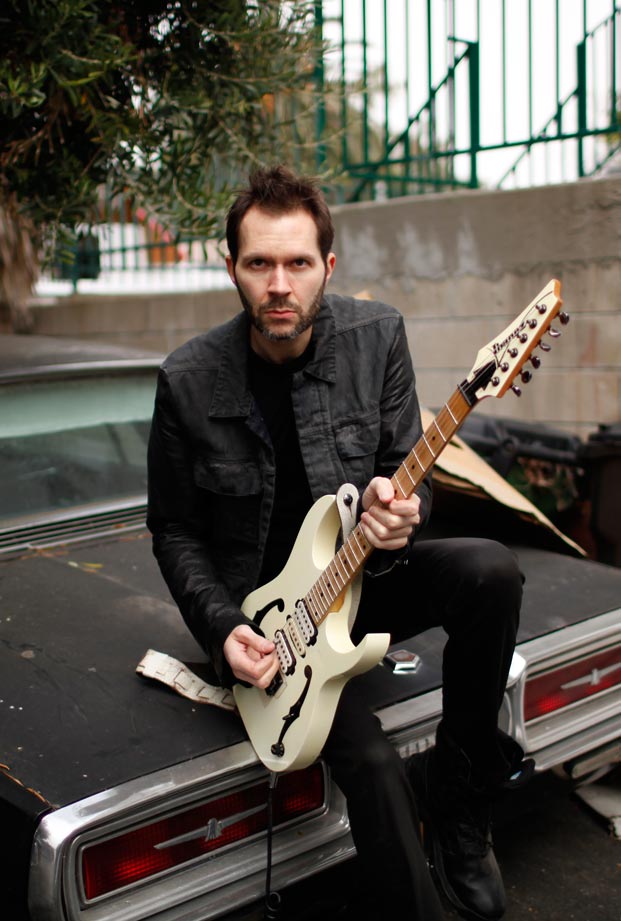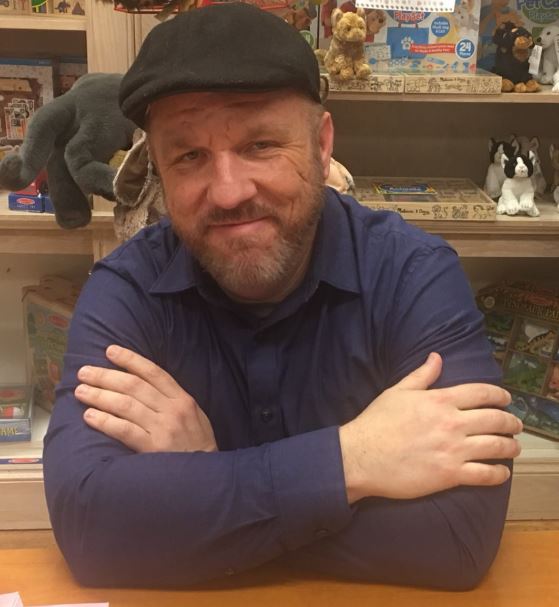'I Can Destroy': Paul Gilbert Talks New Album, Gear and Great Guitar Escape

It's a question every artist has to grapple with: If you're not pushing yourself creatively, how can you grow?
That's exactly what Paul Gilbert tackles—with fervor—on his new solo album, I Can Destroy, which will be released May 27.
On the album, which was produced by Kevin Shirley (whose credits include Mr. Big's 2011 album, “What If”), Gilbert cuts a wide swath of styles and textures. There's the full-frontal assault of “Everybody Use Your Goddamn Turn Signal,” the jazz-blues lament of “One Woman Too Many” (which also features Gilbert's patented Makita drill-bit riffery) and the gut/heart punch of “I Am Not the One (Who Wants to Be with You).” Its playful title references the ubiquitous Number 1 hit Gilbert enjoyed as lead guitarist for Mr. Big.
I recently spoke with Gilbert about I Can Destroy, this year's Great Guitar Escape, his current setup and more.
How would describe I Can Destroy in terms of its sound—and maybe even how it relates to some of your previous solo albums?
The album sounds like an electric brontosaurus, dropped from a 40-story building, landing on a giant sheet of aluminum foil, plugged into a 200-watt Marshall, in the key of F#! [laughs]. Seriously, there are three guitar players on the album—Tony Spinner, Freddie Nelson and myself. So we could do lots of three-part guitar harmonies. It was great to have a big band so I didn't need to do overdubs. Tony and Freddie are also great singers, so we included lots of vocal harmonies, and whenever the bridge was too high for me, Tony would save the day.
How did you approach writing for this album?
Get The Pick Newsletter
All the latest guitar news, interviews, lessons, reviews, deals and more, direct to your inbox!
I turn complaining into music! I'm thinking I might have invented a new style. I call it “cantankerous rock.” If you look at songs from my last few albums, you can see how I've been building up to this. “Get Out of My Yard” is certainly a cantankerous title. “Atmosphere on the Moon” [from Vibrato] was about being so misanthropic that I ask today's young scientists to fabricate an atmosphere on the moon so I can escape their dreadful auto-tuned music here on Earth. “Everybody Use Your Goddamn Turn Signal” from the new album certainly sends a cantankerous message. But these are all lyrics, and guitar players usually care more about the guitar. Actually, I do too, but it's a lot easier for me to write a meaningful guitar riff if I have a lyric to give the song some structure.
What was it like working with Kevin Shirley on this project?
It was very similar to when I worked with Kevin with Mr. Big. Only with this record, we recorded about twice as fast. We recorded my songs so quickly that I started to run out of them. That gave me the chance to do one cover—Ted Nugent's “Great White Buffalo.” Overall, when I work with Kevin I know he's going to steer me in the best direction to make the album sound great and rock.
I'd like to ask you about a few songs from I Can Destroy. Maybe you can tell me what inspired them, how they were written—or whatever comes to mind. Let's start with "Everybody Use Your Goddam Turn Signal."
I lived in Los Angeles for around 20 years. I love the place, but the driving can wear thin. I recently moved to Portland, Oregon, where I can walk and ride my bicycle everywhere. I'm hoping my misanthropic tendencies will relax a bit from being a pedestrian. Musically, I like that the riff swings. I love that the word “goddamn” is sung with big, beautiful harmonies. And I like making the turn signal sound with my guitar by picking muted high strings. The solo is a trade-off with me first, then Freddie and then Tony. The original performance had a much longer solo, but I cut it shorter for the album. Live, I'll probably make it long again.
"One Woman Too Many"
Years ago, I read some books about how chimpanzees are extremely polygamous and genetically very similar to humans. The idea that men are genetically predetermined to want a variety of women is not new or unfamiliar. And I used two chords I learned when I went to school. Emin9 and Amin11. I also pulled out the Makita drill for this one. I'm now using four picks on the end of the bit. Back in the Eighties, I only used three. Four is faster.
"I Can Destroy"
The intro melody was inspired by giving a lesson at my online school. I was trying to come up with a phrase that would help a student improve the accuracy of their picking with string skipping. The lesson evolved into the melody. The lyrics were inspired by watching my young boy destroy things in order to learn about them. Even sophisticated scientists do this. At CERN, physicists are smashing atoms together so they can have a better look at the pieces. And two of my guitar heroes, Jimi Hendrix and Pete Townshend, were no strangers to smashing things up.
"Adventure and Trouble"
That was inspired by my first meeting with Kevin Shirley about working on the album. I was driving home and thinking about what rock and roll should be about. “Adventure and Trouble!” I thought. I sang the song first and then added the chords later. I'm certainly no expert on gospel chord progressions, but I think this might be one. And I like it a lot!
"I Am Not the One (Who Wants to Be with You)."
My record company guy from Japan suggested I invite Eric Martin (Mr. Big) to sing on a couple of songs. Eric was on tour in Europe at the time, so we couldn't make it work out, but the idea inspired two songs—“I Am Not the One (Who Wants to Be with You)” and “Love We Had.” The first made me laugh from its rebellious message. The second is a lyric of sincere appreciation. This is actually not the first time I've written an “anti-song.” I wrote a song called “I'm Not Addicted,” on my United States album with Freddie Nelson, which is sort of the opposite of “Addicted to That Rush."
What can you tell me about this year's Great Guitar Escape?
Once again, I have the honor of presenting a stunning line up of musicians. Andy Timmons, Bruce Bouillet, Kiko Loureiro, Bumblefoot and Dave Ellefson will be there teaching, jamming and hanging out. And I'll be there making sure everything goes smoothly and, of course, doing my own performances, jam sessions and seminars. It's intense and relaxing at the same time. Non-stop guitar by the beach!
What do you enjoy most about these camps?
I work hard to give my best for everyone who comes to the camp, but it's great to see all of the other teachers giving their best, too. The event always feels bigger and better than just me. More specifically, I love the concerts where we all jam together, and I love jamming with the students. It's all about music and guitar, and it's great to hang out with like-minded people.
What's your current gear setup like these days?
Ibanez guitars—old and new. I still love my Fireman model, and my old PGMs and RGs still rock. I just did a couple recording sessions with a Kemper Profiler, and it really sounded great. I still use my Marshalls as well. I assemble whatever pedals are best for the gig. The MojoMojo pedal from TC Electronics and the MXR Phase 90 Script with LED are always on the board. Lately, I've switched to really light picks. I've been using Tortex “The Wedge” with a .50mm thickness.
What excites you the most about the new album and this next phase of your career?
I'm starting to know the fretboard well enough where I don't really have to hear myself. I can hear the melodies in my head, and I know what they look like before I play them. This gives me freedom. I don't have to worry so much about monitors or headphones. I can just jam some earplugs in to protect my hearing, and as long as I can feel the kick and snare, I can lock in with the band. I also don't have to look at the fretboard as much. I can close my eyes and look at the other musicians or just look at the audience. There are old songs like “Scarified” where I still have to look at the neck, because the parts are so strict, but I'm happy to have new songs where I can stretch out and play what I feel in the moment. I want to bend strings, make faces, stir people up with some athleticism, laugh at my cantankerous feelings…and rock and roll!
For more about Gilbert, his new album and the Great Guitar Escape, visit paulgilbert.com and check out the all-new June 2016 issue of Guitar World.

James Wood is a writer, musician and self-proclaimed metalhead who maintains his own website, GoJimmyGo.net. His articles and interviews are written on a variety of topics with passion and humor. You can follow him on Twitter @JimEWood.
James is a guitarist and freelance writer who's interviewed some of the biggest names in music. He is the author of four books and his writing credits include work for Guitar World, AXS and Yahoo! as well as for his hometown newspaper where he writes on a variety of topics with both passion and humor. As a guitarist, he's performed everywhere from local bars and nightclubs to some of the biggest stages in front of thousands of music fans.
“There’d been three-minute solos, which were just ridiculous – and knackering to play live!” Stoner-doom merchants Sergeant Thunderhoof may have toned down the self-indulgence, but their 10-minute epics still get medieval on your eardrums
“There’s a slight latency in there. You can’t be super-accurate”: Yngwie Malmsteen names the guitar picks that don’t work for shred










